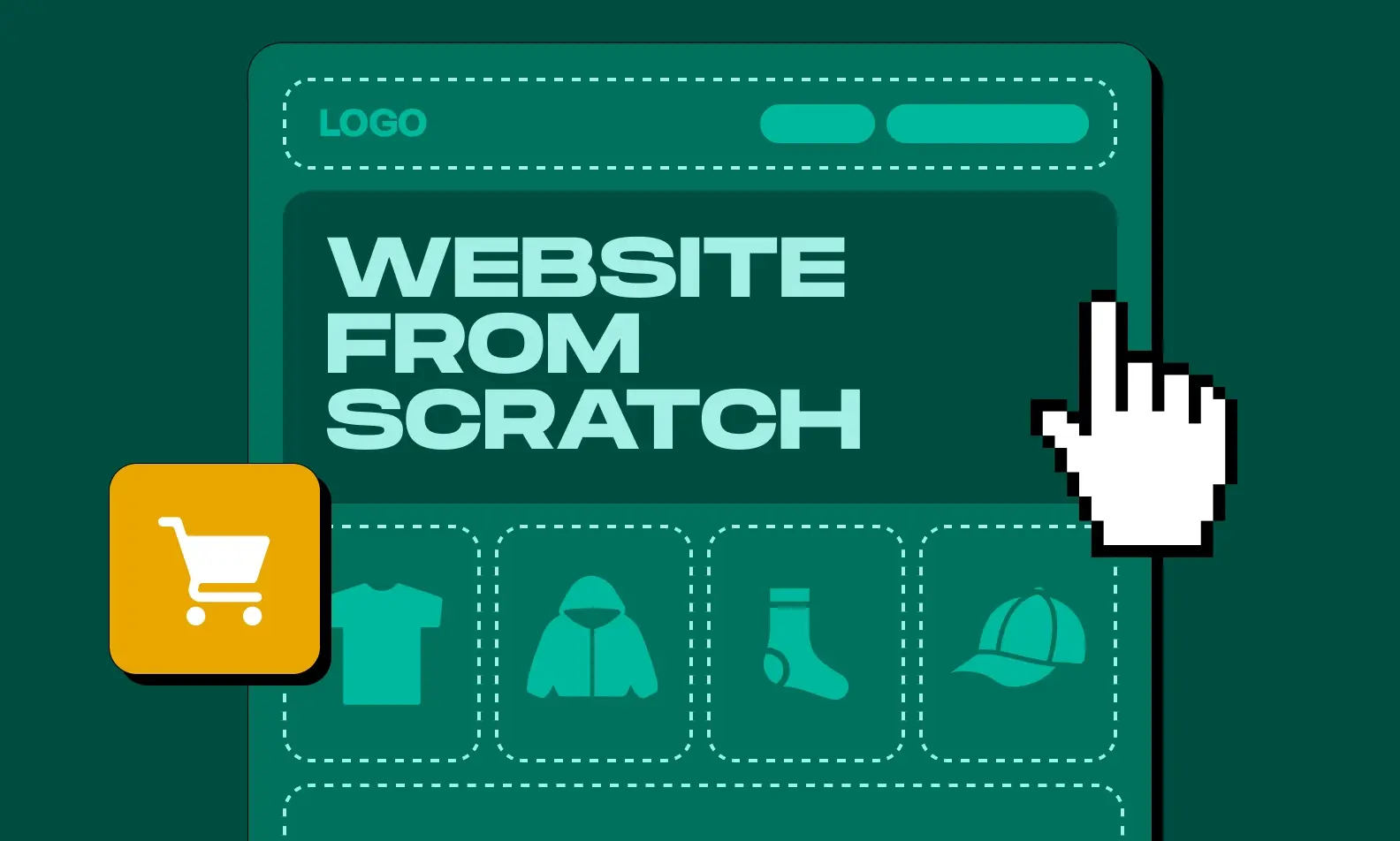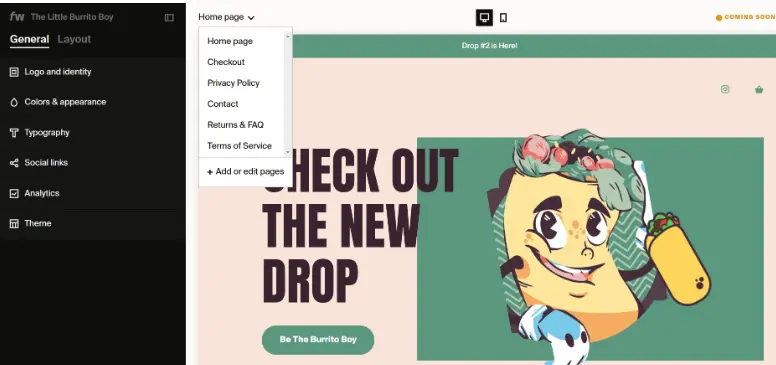How to Build a Website From Scratch: A Blueprint for Creators

Are you a content creator looking to improve your online presence and connect with a wider audience?
Having a social media presence is one thing, but if you're looking to enhance your brand's visibility and take your engagement to the next step, having your own website is critical.
Now, we know building a website might sound like a daunting task, but fear not! We're about to embark on a journey that's simpler than you might think.
The days of needing coding skills or hiring a developer are long gone. With the right tools, you can create a professional website from scratch in no time. Below is our comprehensive guide to building your first website and the tools you need to make your brand or business shine online, so let’s dive right in!
9 Steps to Make a Website From the Start
1. Choose the Right Website Builder
Do you truly need a website builder to establish your online presence? In essence, no. If you possess coding skills, constructing a website from scratch using a code editor and languages like HTML, CSS, and JavaScript is feasible. Nonetheless, this method demands substantial time, expertise, and experience.
Alternatively, you could hire a web developer to craft a website for you. Typically, they would tailor an existing template and utilize platforms like WordPress, a prevalent content management system (CMS), to set up your site. While this approach is popular, especially for blogs, it has its drawbacks, notably the constant need for WordPress updates and its less intuitive dashboard. Visual customization beyond template offerings often necessitates developer assistance.
For a more cost-effective and flexible solution, consider employing drag-and-drop website builders. These builders are particularly beneficial for small online businesses. They offer pre-designed templates and intuitive user interfaces (UIs) and require no HTML or CSS knowledge. Furthermore, they eliminate the need for constant updates, ensuring your website is swiftly up and running without interruptions.
Website host providers like Squarespace, Wix, and GoDaddy are the best options for building your first website. However, if you're interested in e-commerce and want to set up your own store, consider using Fourthwall for a more intuitive design that will help you sell your products.
2. Select a Compelling Domain Name
Selecting a compelling domain name is like crafting the title of your favorite book—it's vital to directing people to your site and ensuring it remains memorable.
If your web hosting provider offers a free domain name for the initial year of service, you've already taken a significant step in this process. Web hosting platforms like GoDaddy and Squarespace already provide domain name search tools so you can see if your name is already in use or not.
Consider these essential tips when choosing your domain name: prioritize brevity and memorability to ensure it sticks in people's minds. Incorporating relevant keywords into your domain not only aids in SEO but also distinguishes your website within your business niche. Conduct thorough research to avoid conflicts with existing domain names and to maintain brand differentiation across platforms.
When choosing a domain name extension, such as .com, .org, or .biz, opt for .com as it's the most widely recognized and commonly assumed TLD by potential site visitors. With your web hosting plan secured and a custom domain in hand, you're ready to begin building and launching your website.

3. Design Your Website Layout
Let's make your digital space visually appealing! Walk through the process of designing a layout that reflects your unique style and enhances the user experience.
Within your website builder, you'll find features enabling you to add, remove, and customize pages, incorporate various content types, integrate contact and subscription forms, embed social media icons, and tailor navigation menus.
Additionally, you can manage website and page settings, integrate external tools like Google Analytics, and even set up an online store or membership site. Some website builders may also offer tools for easy migration and color palette creation based on your company logo.
As you curate your website's content, consider including essential pages such as the homepage, about us, contact, offers, blog, FAQ, reviews, and testimonials. These pages not only provide vital information but also contribute to building trust, engaging visitors, and driving conversions.
For creators wanting a much simpler approach to their layout's design, consider choosing a one-page website design, which offers easy navigation and a more immersive feel.

4. Integrate Multimedia Elements
Enhancing your website with multimedia elements is key to captivating and retaining visitors' attention. Optimizing how you present information as users interact with your site is also essential.
Start by considering the range of content you can incorporate, including text, photography, videos, animations, and more. Once you've identified your options, focus on organizing them effectively to create a pleasant experience for your users.
Maintaining a clear content hierarchy is vital for visitor engagement and navigation. Strategically place your most compelling and essential content above the fold to ensure it's immediately visible without scrolling.
Remember to utilize your site's media features by uploading content such as YouTube videos, live streams, or podcasts. This puts your content on full display for your viewers and acts as a map to all your platforms.
5. Optimize for SEO
As you prepare to launch your new website, securing acknowledgment from Google is crucial for attracting potential customers and driving engagement—this is where SEO comes in handy.
Search Engine Optimization (SEO) involves improving your site's pages to rank higher in search engine results, thus increasing exposure and the likelihood of visitors making purchases or consuming content.
Learn essential optimization techniques to make sure your digital presence doesn't go unnoticed. Conducting thorough keyword research to identify relevant terms, then optimize individual pages with those keywords while ensuring high-quality content creation across different formats.
Continuously monitor your website's performance using tools like Google Analytics and Google Search Console. These tools help in tracking keyword rankings, traffic metrics, user engagement, and conversion rates. Use data-driven insights to identify areas for improvement and refine your SEO strategy accordingly.
6. Set Up E-commerce Features
For aspiring online store owners, consider using platforms like Fourthwall, which offers comprehensive tools to kickstart your e-commerce venture. With Fourthwall, creators can easily design and customize products, leveraging tools for both creating new items and selling existing ones.
With access to a vast catalog of retail-quality products spanning apparel, accessories, and digital goods, creators have the flexibility to curate their inventory according to their brand vision and audience preferences.
The platform streamlines the design process, offering user-friendly tools and resources such as Canva integration and collaboration with trusted designers, ensuring that designs meet quality standards and resonate with customers.
In addition to product creation and customization, Fourthwall empowers creators to design and personalize their e-commerce websites to reflect their unique brand identity. With a variety of customizable themes and features for logo integration, color and font customization, and layout adjustments, creators can establish visually appealing and cohesive storefronts that enhance brand visibility and engagement.
7. Ensure Mobile Responsiveness
In a world glued to smartphones, mobile responsiveness is key. Make sure whatever website builder you use offers responsive design templates that automatically adjust layout and content based on screen size.
Pay attention to font sizes, spacing, and button sizes to ensure they are touch-friendly and easy to interact with on mobile devices.
Preview your website regularly in mobile view to identify and address any issues related to mobile responsiveness. Use built-in features or plugins provided by your website builder to improve images and media for faster loading times.
With platforms like Fourthwall, you can tailor your site's design and layout to mobile phones by utilizing responsive themes and customizable templates with Fourthwall's Mobile Apps. This feature allows your supporters to download your site in a customized app and gain instant access to your shop and members' area.
8. Configure Analytics Tools
Integrating analytics tools into your website is crucial for gaining insights into your audience's behavior and improving your site for success. By configuring analytics tools, such as Google Analytics or Cyfe, you can track metrics like website traffic, user engagement, and conversion rates.
Understanding these metrics allows you to make data-driven decisions to improve user experience, identify areas for optimization, and tailor your content to better meet your audience's needs.
Additionally, analytics tools provide valuable demographic information, such as geographic location and device usage, helping you refine your marketing strategies and more effectively target specific audience segments.
By regularly analyzing website performance metrics, you can identify trends, measure the impact of website changes, and ultimately enhance your website's overall performance and success.
9. Test and Launch
Before the grand reveal, ensure everything is in place. This includes testing website functionality across different browsers and devices to ensure compatibility and responsiveness.
Conduct testing on your site's usability to gather feedback on navigation, user interface elements, and overall user experience. Check for broken links, missing images, and any other technical issues that may detract from the user experience. It's also important to review content for accuracy, relevance, and consistency.
By thoroughly testing your website before launch, you can identify and address any issues or concerns, ensuring a smooth and successful rollout that leaves a positive impression on your visitors.
How to Build a Website from Scratch with Fourthwall
Ditch the coding woes and unleash your creative vision with Fourthwall's no-code website builder. Choose from stunning themes, tailor them to your brand, and launch your custom storefront effortlessly. Here's how in just three simple steps:
- Pick your canvas: Dive into a collection of beautiful themes, from sleek and modern to bold and playful. Customize colors, fonts, and layouts to make it your own.
- Fill it with your passion: Upload your designs, choose products like tees and mugs, and set your prices. Integrate with your favorite platforms like Instagram and TikTok to reach your fans wherever they are.
- Launch and let it shine: With a click, your store is live! Fourthwall handles printing, shipping, and customer support, so you can focus on what you do best - creating awesome stuff.
Your Website, Your Way: Explore Fourthwall's Creator Paradise
A well-designed website is your canvas to showcase your work, connect with your audience, and establish your brand. Focus on your art, not the tech, and let Fourthwall handle the rest – from top-notch product quality to dedicated customer support. Build your dream store, express your passion, and connect with your fans like never before. Get started today!
















